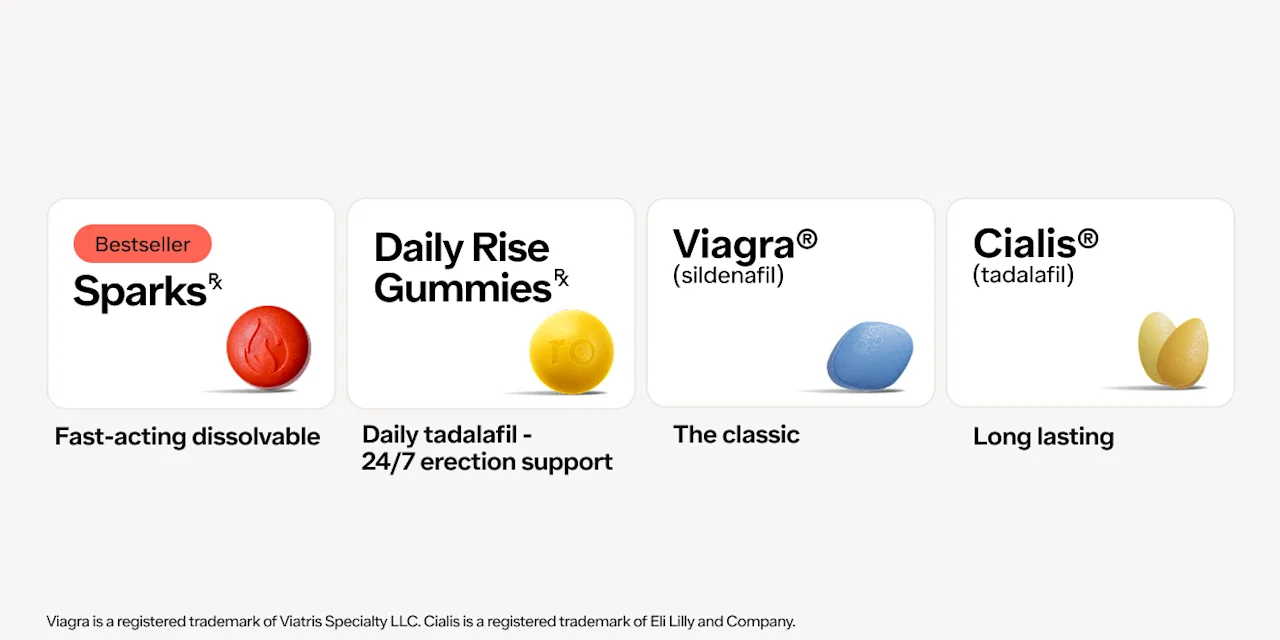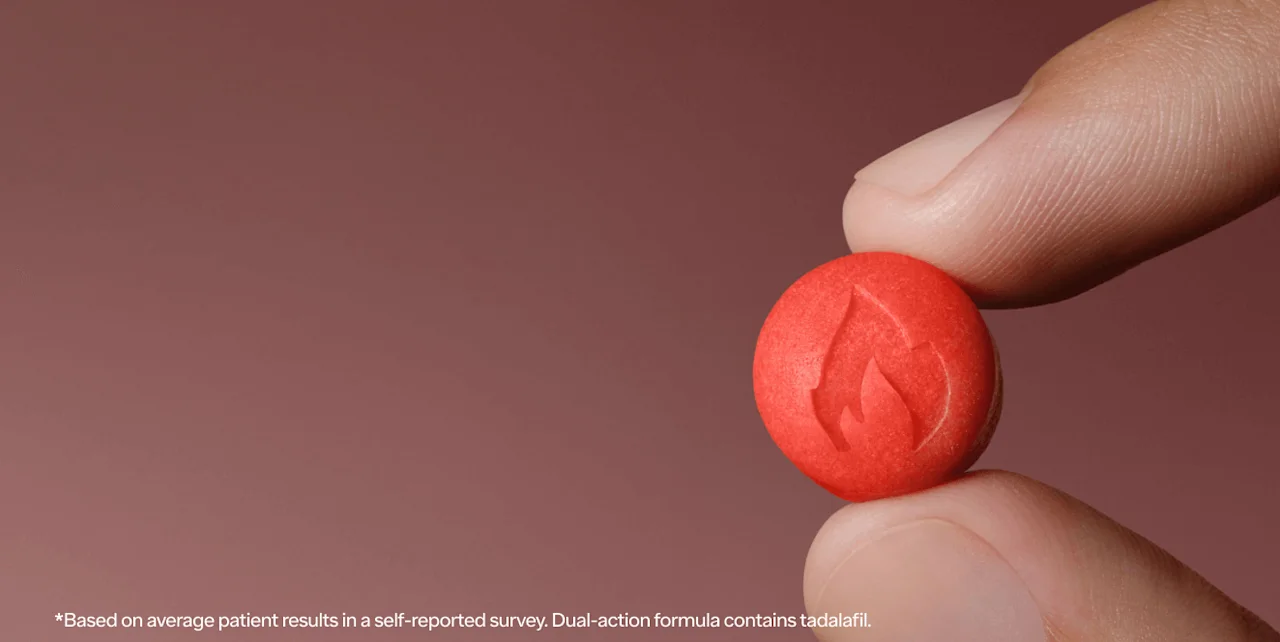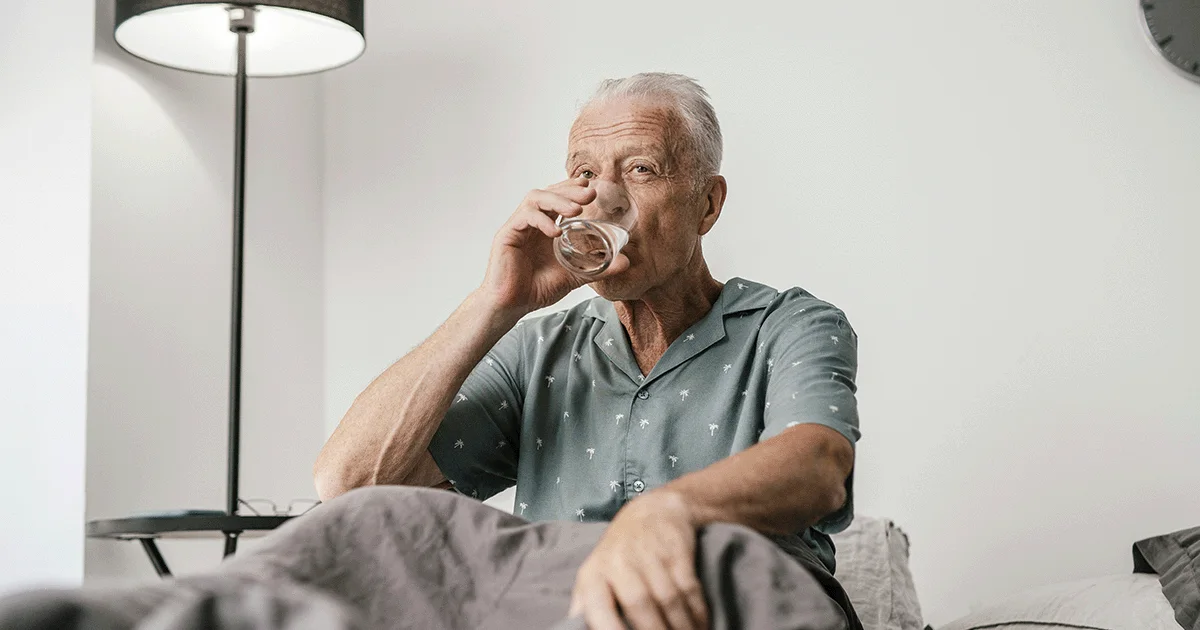Key takeaways
Temporary erectile dysfunction (ED) typically lasts less than six months, although that’s not an official medical term.
You can develop temporary ED as a side effect to certain medications or because of an untreated medical condition.
It’s also possible to have situational ED, where you only have erectile trouble in some situations but not others.
Regardless of how long you experience ED, the most common treatments are pretty much the same: medications like Viagra or Cialis, lifestyle interventions like diet and exercise, and mental health treatment as needed.
Here's what we'll cover
Here's what we'll cover
Here's what we'll cover
Key takeaways
Temporary erectile dysfunction (ED) typically lasts less than six months, although that’s not an official medical term.
You can develop temporary ED as a side effect to certain medications or because of an untreated medical condition.
It’s also possible to have situational ED, where you only have erectile trouble in some situations but not others.
Regardless of how long you experience ED, the most common treatments are pretty much the same: medications like Viagra or Cialis, lifestyle interventions like diet and exercise, and mental health treatment as needed.
If you’ve suddenly started having trouble getting or maintaining an erection, you might be wondering how long you can expect these symptoms to last. Is temporary erectile dysfunction (ED) a thing, or should you be prepared to deal with ED for the rest of your life? If it could be a short-term thing, how long does temporary erectile dysfunction last?
Here’s the good news: ED can sometimes be temporary, but even if it’s a longer-term issue, there are safe and effective treatments available.
What is temporary erectile dysfunction?
Temporary erectile dysfunction (ED) isn’t an official medical diagnosis; it’s a general term referring to ED that starts for a short period, then goes away.
Some researchers say a person shouldn’t get a diagnosis of erectile dysfunction unless they’ve had symptoms for at least six months. By that definition, you could say temporary ED is when symptoms improve within six months.
Typically, cases like these come from one of two causes:
Temporary ED: This is usually due to a temporary circumstance, such as taking a particular medication or dealing with a medical condition that causes ED. This type of ED often goes away when you stop the medication or treat the medical condition (under a healthcare provider’s care, of course).
Situational ED: This is when you have ED in some situations, like with a new partner, but not in others, like masturbating on your own. Often, this comes from performance anxiety or relationship troubles. When the particular circumstance at hand resolves, or the anxiety related to it subsides, you’ll often regain normal sexual function. Situational ED can be a form of temporary ED.
In either case, your symptoms of ED might go away once you resolve what’s causing those symptoms. For example, if you started on a medication and noticed erectile problems shortly thereafter, you can speak to your healthcare provider about switching to another medication.
In many cases, stopping the culprit medication will resolve any sexual problems. And on the situational side, if your ED is coming from new relationship anxiety, for example, that should resolve with time and once you address the underlying issues.
Even if you think you know what might be causing your erectile dysfunction, it’s important to speak with a healthcare provider about what’s going on if you’re noticing more issues with maintaining an erection than you used to. ED can also be related to health conditions, like heart disease or obesity and it’s important to get checked out to see if there are any health conditions that need to be taken care of. Sometimes, addressing those underlying causes can help restore sexual function.
Symptoms of temporary erectile dysfunction
So, how do you know if your erectile dysfunction is temporary or long-term? The truth is, you won’t know for sure until your symptoms have been going on for at least six months, at which point a healthcare provider will likely diagnose you with ED. The symptoms are the same, though. The official definition of erectile dysfunction is the inability to achieve or maintain a rigid enough penile erection suitable for satisfactory sexual intercourse. Symptoms can include:
Not being able to get an erection when you want to (or when it’s expected, like when you’re sleeping or when you wake up in the morning)
Losing erections more quickly than you or your partner would like for satisfying sex
These symptoms are the same whether you’ve been struggling with ED for a while (say, longer than six months), or if it’s a new issue. If there has been a recent change in your routine like a new stressor or a new potentially causative medication, you have good reason to believe your ED could be temporary.
Causes of temporary erectile dysfunction
Temporary ED — meaning, ED that goes away within six months — can happen for a few different reasons.
Medication-induced ED
ED can be a side effect of certain medications. The most common medications that are known to have ED as a possible side effect include:
Antidepressants, especially SSRIs (like Prozac or Zoloft)
Antipsychotic medications (like Risperidone)
Opioids
Some recreational drugs
If your erectile issues started shortly after starting a new medication, speak to your healthcare provider. There may be other medication options to treat your condition without as much risk of sexual side effects. For example, Wellbutrin is a different kind of antidepressant that does not typically cause ED.
Even if you suspect a medication is causing your ED, don’t stop taking it without first speaking with your healthcare provider. Some medications need to be tapered off slowly, and stopping them abruptly could cause issues or even be dangerous.
Untreated medical conditions
Some medical conditions can cause ED, and treating those conditions can resolve erectile problems. (In some cases, medications like Viagra or Cialis may also be needed initially or in the longer term, depending on how your body has been impacted by these conditions and how it responds to treatment.)
For example, low testosterone may contribute to ED and even low libido. Treating low T with testosterone replacement therapy (TRT) can help if your levels are found to be low and it’s thought to be a contributing factor to your symptoms. It’s important that men who are trying to conceive exercise caution, since TRT lowers sperm production. Discuss this with your healthcare provider because there may be other treatments available.
Other medical conditions, like atherosclerosis and hypertension, can also lead to ED, and treating those underlying conditions and implementing lifestyle changes could potentially resolve the blood flow issues leading to erectile problems over time.
Similarly, obesity is highly correlated with ED, so weight loss (through lifestyle alone, or along with help from medications like Wegovy or Mounjaro) may help restore good erectile function.
Lifestyle causes or situational ED
Situational ED is when you have problems getting or maintaining an erection in some situations but not in others. For example, you might have no trouble when masturbating on your own, but all of a sudden, when you’re with a partner, trouble arises.
For some, this can come from sexual performance anxiety, where someone can experience so much anxiety around their ability to perform that it causes them to lose their erection (or be unable to get one in the first place). In some cases, a person may experience ED at the start of a new relationship, where the pressure to perform may feel more intense, causing sexual performance anxiety. This is usually temporary and can improve as a person gets more comfortable in the relationship. Situational ED can also happen if there is conflict in the relationship, in which case an open conversation with your partner and perhaps looking into couple’s therapy or talking to a sex therapist could also help.
Work stress can also be a part of this. If it’s been especially busy at work or you are experiencing work-related stress for another reason, you might find yourself losing interest in sex and even experiencing temporary ED when you are thinking about work. This should most likely resolve once your situational stressor goes away. Stress management techniques may also help.
Another lifestyle cause that can bring on ED temporarily is excessive alcohol consumption. While you might think alcohol can get you in the mood, many men find that it causes them to lose their erection quickly or to experience premature ejaculation. This is more likely to happen with excess alcohol use rather than with just one alcoholic drink, but everyone’s body is different.
Other lifestyle causes, such as smoking, being overweight or watching too much porn could also cause temporary ED that may go away with lifestyle changes.
Other causes of ED
If you’ve ruled out temporary or situational ED, or if your symptoms are persisting even after addressing what you suspect might be causing your ED, there might be some other things at play. It’s also important to know that ED can come from multiple causes at once.
In addition to the medical conditions we mentioned already — low T, obesity, atherosclerosis, and high blood pressure — ED can be caused by:
Neurological diseases (like multiple sclerosis)
Psychological disorders (like depression or anxiety)
ED can also come from physical trauma to the pelvis or spinal cord, or from certain surgeries.
The full list of possible causes of erectile dysfunction is quite long, but this abbreviated list should already give you a good picture that this condition is complex and can come from a lot of different places. Thankfully, no matter where it’s coming from — or whether it’s a temporary or long-term condition — there are many treatment options available.
How long does temporary erectile dysfunction last?
Guidelines define temporary ED as lasting up to six months; after that point, it’s considered a chronic condition.
Even though “temporary ED” isn’t an official medical term, the guidelines state that a diagnosis of erectile dysfunction only applies once someone has been having erectile troubles for at least six months. This is likely because anyone can have an episode of ED, or even several episodes, without it indicating a longer-term issue. So many factors can play a role in erectile function, including your stress levels, how well rested you are, your relationship with your sexual partner, and myriad other factors.
One episode of ED doesn’t mean it will continue in the long term. It could happen only once in a while or only in certain situations. If it is medication-related, talking to your healthcare provider and changing your medications around could help it go away. Some people might experience ED that does end up going on for a more extended period of time. Not to worry. No matter how long your ED has been going on, if it is impacting you and your lifestyle, there are treatments available.
How to treat temporary erectile dysfunction
The treatments for temporary ED are mostly the same as those for ongoing ED. There are several effective medication options, lifestyle factors that can help, and in some cases, mental health counseling may be recommended.
Where treatment differs for temporary erectile dysfunction vs. long-term ED is when it comes to more invasive options, like surgical procedures (penile implants) or penile injections. Those are usually not recommended unless other therapies aren’t working well enough or aren’t right for you, so they probably wouldn’t be recommended if your ED has only been going on for a short period of time.
Let’s take a look at the most common treatments you’ll likely encounter for temporary (or ongoing) ED.
ED medications
Whether you have temporary or long-term ED, your healthcare provider will most likely recommend starting your erectile dysfunction treatment with a type of drug called a PDE-5 inhibitor.
These oral medications work by inhibiting an enzyme called phosphodiesterase-5 (PDE-5), which triggers a cascade of effects that ultimately open up the blood vessels and help more blood flow into the penis. Since blood flow to the penis is essential for erections , these drugs make it possible for most people to get an erection when sexually stimulated. (In other words, you won’t spontaneously get an erection after taking these medications without being aroused and stimulated).
The most common PDE-5 inhibitors include:
Stendra (avanafil)
These medications all work in the same basic way, but have different dosages, kick in at different time marks, and last for different amounts of time in the body. They can all be taken on an as-needed basis, generally within an hour or so of when you plan to have sexual intercourse. They do not cause you to have an instant erection; rather, they set the stage so you’re able to get an erection if you want to, with sexual stimulation.
For longer-term ED, Cialis is also available in a daily formula at lower dosages than what is typically recommended for as-needed use, allowing for more spontaneous sex. Be sure to discuss this option with your healthcare provider if you think it might be the right choice for you.
Ro also offers different formulations of sildenafil and tadalafil, the active ingredients in Viagra and Cialis, respectively. One formulation is Ro Sparks, a dissolvable tablet that contains both drugs. Another is Daily Rise Gummies, a chewable gummy containing Cialis that’s meant to be taken daily. While the United States Food and Drug Administration (FDA) has not approved these specific formulations, they are prescribed off-label at the discretion of healthcare providers. Their active ingredients are individually FDA-approved for treating ED.
Lifestyle changes
Medications like Viagra and Cialis work well for the vast majority of people with ED, but medication is just one piece of a pretty complex puzzle. Many things in the body need to be working properly for erections to happen as they should.
One of the keys to a healthy erection is proper blood flow to the penis, which requires good blood flow throughout the body. So, that means if your overall health isn’t great, you’re more likely to experience erection problems. That’s why conditions like cardiovascular disease, high blood pressure, high cholesterol, and type 2 diabetes can contribute to ED, since these conditions all affect the health of your blood vessels and, ultimately, blood flow.
Maintaining a healthy lifestyle with a balanced, healthy diet and regular exercise is important for your overall health, and that extends to your erectile function. Whether your ED is new or you’ve been experiencing it for a while, adopting healthy lifestyle habits is a good idea, along with any medical interventions you and your healthcare provider decide to make.
Therapy for erectile dysfunction
When it comes to the role of psychological factors in erectile dysfunction, it’s often a chicken-or-egg situation: Did psychological causes lead to ED, or has ED caused psychological issues to crop up?
It’s often hard to know which came first, but what’s most important is the impact these conditions are having on your life. Conditions like depression and anxiety can contribute to ED, but having ED can also take a huge toll on a person’s mental health and self-esteem, often leading to depression or anxiety over time.
Psychotherapy can be very helpful in managing the psychological aspect of ED. Some researchers have found that people with ED get better results from sildenafil (aka generic Viagra) and other ED treatments when taken in conjunction with psychotherapy.
One promising new approach to psychotherapy for ED is called cognitive behavioral sex therapy, based on the principles of cognitive behavior therapy (CBT). It’s in the early stages of development but may offer added help for managing erectile dysfunction or other sexual dysfunction. At times, it can be helpful to meet with a couple’s therapist or sex therapist if ED is having a significant impact on your relationship.
Bottom line
If you’re having difficulty getting or maintaining an erection, don’t hesitate to reach out to your healthcare provider. Regardless of how long this issue has been going on, even if it’s new and you think there’s a chance it could be short-term, there are many treatment options that can help.
Temporary ED is not an official medical diagnosis, but typically, it is when erectile problems last for six months or less.
It can happen as a side effect to certain medications or due to specific medical conditions that can cause ED if untreated.
You may also experience situational ED, where you have no trouble getting an erection in some situations but can’t in others. This is often due to psychological or relational causes.
Whether you’ve recently developed ED or it’s become a longer-term issue, the treatments are similar. ED medications (like Viagra or Cialis), lifestyle changes, and psychological help are all effective ways of regaining the satisfying sex life you deserve.
Frequently asked questions (FAQs)
How long does it take for temporary ED to go away?
Temporary ED should go away within six months. If your symptoms persist beyond that, you qualify for an official erectile dysfunction diagnosis. Of course, if symptoms are having a significant impact on your life it might still be helpful to seek medical attention on the earlier side of your symptoms.
How do I know if my ED is temporary?
Temporary ED isn’t an official medical term — it just describes erectile trouble that lasts for a short period of time (six months or less). Unfortunately, there’s no way to know for sure if your ED will be a short-term or long-term issue until you get to that six-month mark.
Regardless, the treatments are the same, and it is absolutely possible to have a satisfying sex life with ED. Remember that at the end of the day, everyone’s body is different. Some official guidelines have suggested the six-month mark, but if you are experiencing bothersome symptoms, there is no harm in seeking medical attention on the earlier side.
Does ED ever fix itself?
It is possible to have episodes of ED that resolve without treatment. For example, if you have situational ED that’s happening because of performance anxiety in a new relationship, that will generally resolve on its own as you get more comfortable in the relationship.
One clue of psychologically-based ED would be that there is no change to your morning erections or erections that occur during sleep. Typically, when there’s a known underlying cause for your ED, you’ll need to address that or treat your ED directly.
DISCLAIMER
If you have any medical questions or concerns, please talk to your healthcare provider. The articles on Health Guide are underpinned by peer-reviewed research and information drawn from medical societies and governmental agencies. However, they are not a substitute for professional medical advice, diagnosis, or treatment.
Viagra Important Safety Information: Read more about serious warnings and safety info.
Cialis Important Safety Information: Read more about serious warnings and safety info.
Wegovy Important Safety Information: Read more about serious warnings and safety info.
Mounjaro Important Safety Information: Read more about serious warnings and safety info.
References
Acharya, R. K., Panigrahi, S., Samani, M. J., & Choudhary, A. K. (2022). Prevalence and pattern of sexual dysfunction in male patients with alcohol dependence. Addiction & Health, 14(3), 192–197. doi: 10.34172/ahj.2022.1335. Retrieved from https://pubmed.ncbi.nlm.nih.gov/36544980/
Berger, M. H., Messore, M., Pastuszak, A. W., & Ramasamy, R. (2016). Association between infertility and sexual dysfunction in men and women. Sexual Medicine Reviews, 4(4), 353–365. doi: 10.1016/j.sxmr.2016.05.002. Retrieved from https://pubmed.ncbi.nlm.nih.gov/27872029/
Bilal, A. & Abbasi, N. U. H. (2020). Cognitive behavioral sex therapy: an emerging treatment option for nonorganic erectile dysfunction in young men: a feasibility pilot study. Sexual Medicine, 8(3), 396–407. doi: 10.1016/j.esxm.2020.05.005. Retrieved from https://www.ncbi.nlm.nih.gov/pmc/articles/PMC7471093/
Dewitte, M., Bettocchi, C., Carvalho, J., et al. (2021). A psychosocial approach to erectile dysfunction: position statements from the European Society of Sexual Medicine (ESSM). Sexual Medicine, 9(6), 100434. doi: 10.1016/j.esxm.2021.100434. Retrieved from https://www.ncbi.nlm.nih.gov/pmc/articles/PMC8766276/
Dhaliwal, A. & Gupta, M. (2023). PDE5 inhibitors. StatPearls. Retrieved from https://www.ncbi.nlm.nih.gov/books/NBK549843/
Harte, C. B. (2007). Acute effects of nicotine on physiological and subjective sexual arousal in healthy nonsmoking men. Psychopharmacology, 192(4), 517-527. doi: 10.1111/j.1743-6109.2007.00637.x. Retrieved from https://pmc.ncbi.nlm.nih.gov/articles/PMC2864030/
Kalaitzidou, I., Venetikou, M. S., Konstadinidis, K., et al. (2014). Stress management and erectile dysfunction: a pilot comparative study. Andrologia, 46(6), 698–702. doi: 10.1111/and.12129. Retrieved from https://pubmed.ncbi.nlm.nih.gov/23822751/
Landmark, B. F., Almås, E., Brurberg, K. G., et al. (2012). The effects of sexual therapy interventions for sexual problems. Knowledge Centre for the Health Services at The Norwegian Institute of Public Health (NIPH), No. 02-2012. Retrieved from https://pubmed.ncbi.nlm.nih.gov/29319959/
Melnik, T., Soares, B. G., & Nasello, A. G. (2008). The effectiveness of psychological interventions for the treatment of erectile dysfunction: systematic review and meta-analysis, including comparisons to sildenafil treatment, intracavernosal injection, and vacuum devices. The Journal of Sexual Medicine, 5(11), 2562–2574. doi: 10.1111/j.1743-6109.2008.00872.x. Retrieved from https://pubmed.ncbi.nlm.nih.gov/18564156/
Moon, K. H., Park, S. Y., & Kim, Y. W. (2019). Obesity and erectile dysfunction: from bench to clinical implication. The World Journal of Men's Health, 37(2), 138–147. doi: 10.5534/wjmh.180026. Retrieved from https://pmc.ncbi.nlm.nih.gov/articles/PMC6479091/
Naelitz, B. D., Momtazi-Mar, L., Vallabhaneni, S., et al. (2025). Testosterone replacement therapy and spermatogenesis in reproductive age men. Nature Reviews. Urology, 10.1038/s41585-025-01032-8. Advance online publication. doi: 10.1038/s41585-025-01032-8. Retrieved from https://pubmed.ncbi.nlm.nih.gov/40346275/
Park, B. Y., Wilson, G., Berger, J., et al. (2016). Is Internet pornography causing sexual dysfunctions? A review with clinical reports. Behavioral Sciences, 6(3), 17. doi: 10.3390/bs6030017. Retrieved from https://pmc.ncbi.nlm.nih.gov/articles/PMC5039517/
Park, Y. W., Kim, Y., & Lee, J. H. (2012). Antipsychotic-induced sexual dysfunction and its management. The World Journal of Men's Health, 30(3), 153–159. doi: 10.5534/wjmh.2012.30.3.153. Retrieved from https://pmc.ncbi.nlm.nih.gov/articles/PMC3623530/
Patel, A. S., Leong, J. Y., Ramos, L., & Ramasamy, R. (2019). Testosterone is a contraceptive and should not be used in men who desire fertility. The World Journal of Men's Health, 37(1), 45–54. doi: 10.5534/wjmh.180036. Retrieved from https://www.ncbi.nlm.nih.gov/pmc/articles/PMC6305868/
Riley, A. (2002). The role of the partner in erectile dysfunction and its treatment. International Journal of Impotence Research, 14 Suppl 1, S105–S109. doi: 10.1038/sj.ijir.3900800. Retrieved from https://pubmed.ncbi.nlm.nih.gov/11850743/
Rizk, P. J., Kohn, T. P., Pastuszak, A. W., & Khera, M. (2017). Testosterone therapy improves erectile function and libido in hypogonadal men. Current Opinion in Urology, 27(6), 511–515. doi: 10.1097/MOU.0000000000000442. Retrieved from https://pmc.ncbi.nlm.nih.gov/articles/PMC5649360/
Sooriyamoorthy, T. & Leslie, S. W. (2022). Erectile dysfunction. StatPearls. Retrieved on Mar. 12, 2023 from https://www.ncbi.nlm.nih.gov/books/NBK562253/
Wu, X., Zhang, Y., Zhang, W., et al. (2022). The association between erectile dysfunction and sleep parameters: data from a prospective, controlled cohort. The Journal of Sexual Medicine, 19(9), 1387–1396. doi: 10.1016/j.jsxm.2022.07.002. Retrieved from https://pubmed.ncbi.nlm.nih.gov/35909074/
Yannas, D., Frizza, F., Vignozzi, L., et al. (2021). Erectile dysfunction is a hallmark of cardiovascular disease: unavoidable matter of fact or opportunity to improve men's health?. Journal of Clinical Medicine, 10(10), 2221. doi: 10.3390/jcm10102221. Retrieved from https://pmc.ncbi.nlm.nih.gov/articles/PMC8161068/













